Abstract
Gastric cell c-AMP stimulating antibodies (GCS-Ab) were studied in 30 patients with duodenal ulcer (DU) disease. Semipurified immunoglobulin (Ig) preparations from 13/30 patients stimulated c-AMP production in parietal cell enriched gastric cell suspensions obtained from male guinea pig stomachs. Maximum stimulation (varying between 260 and 547%) was reached after four hours incubation with 2 and 4 mg/ml Ig concentrations. The 13 patients with gastric cell stimulating antibodies (GCS-Ab), all male patients, developed the disease at a younger age (nine of 13 under the age of 30), had a longer duration of symptoms (mean 18.4 years), and had a higher incidence of DU in their families (61%). Eight of 13 (61%) in the GCS-Ab+ group did not respond to anti-H2-R drugs, whereas in the negative patients only three of 17 (18%) were classified as 'non-responders'. Remarkably few conventional autoantibodies were detected in our series. Gastric cell stimulating antibodies are a new addition to the growing list of receptor antibodies in human diseases and the described in vitro test should provide an easier tool for screening large populations.
Full text
PDF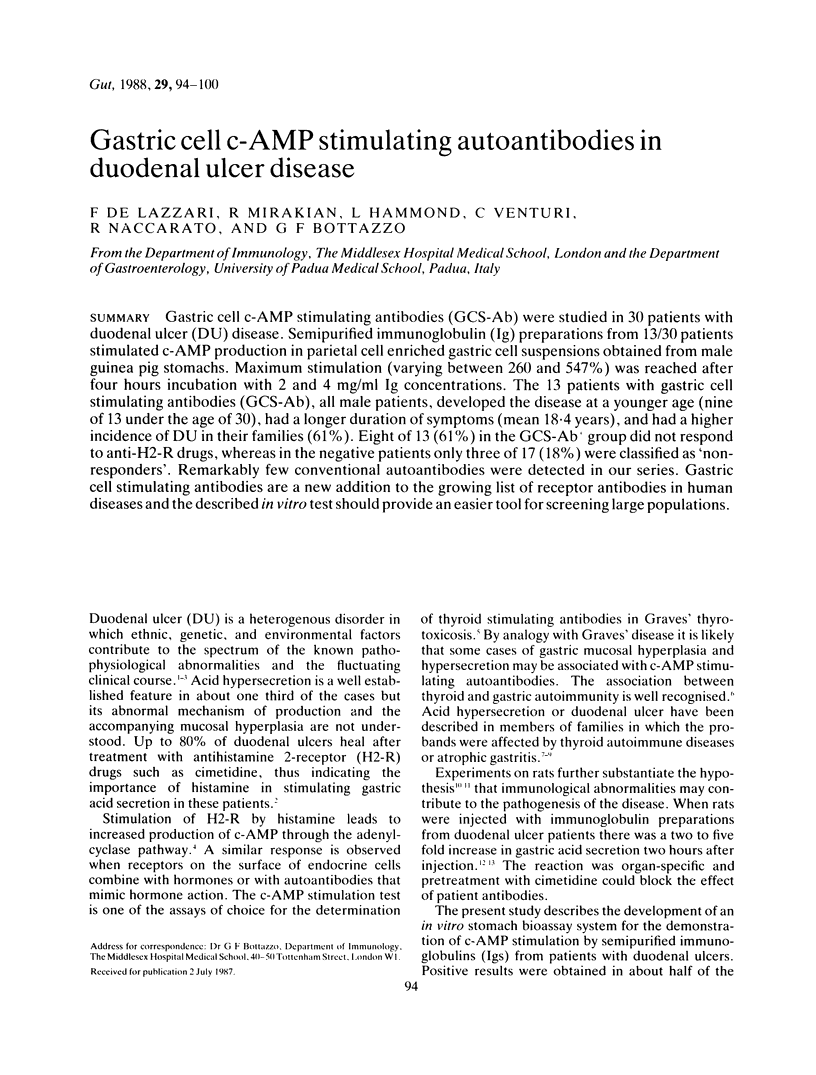
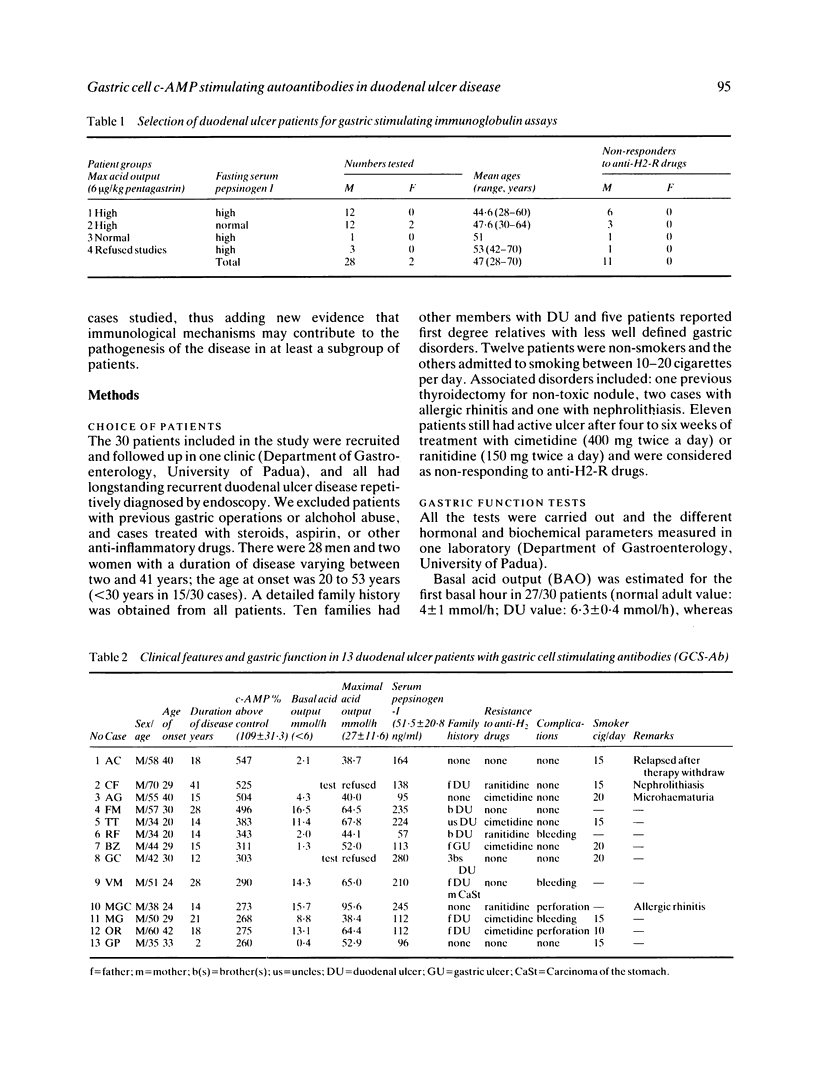
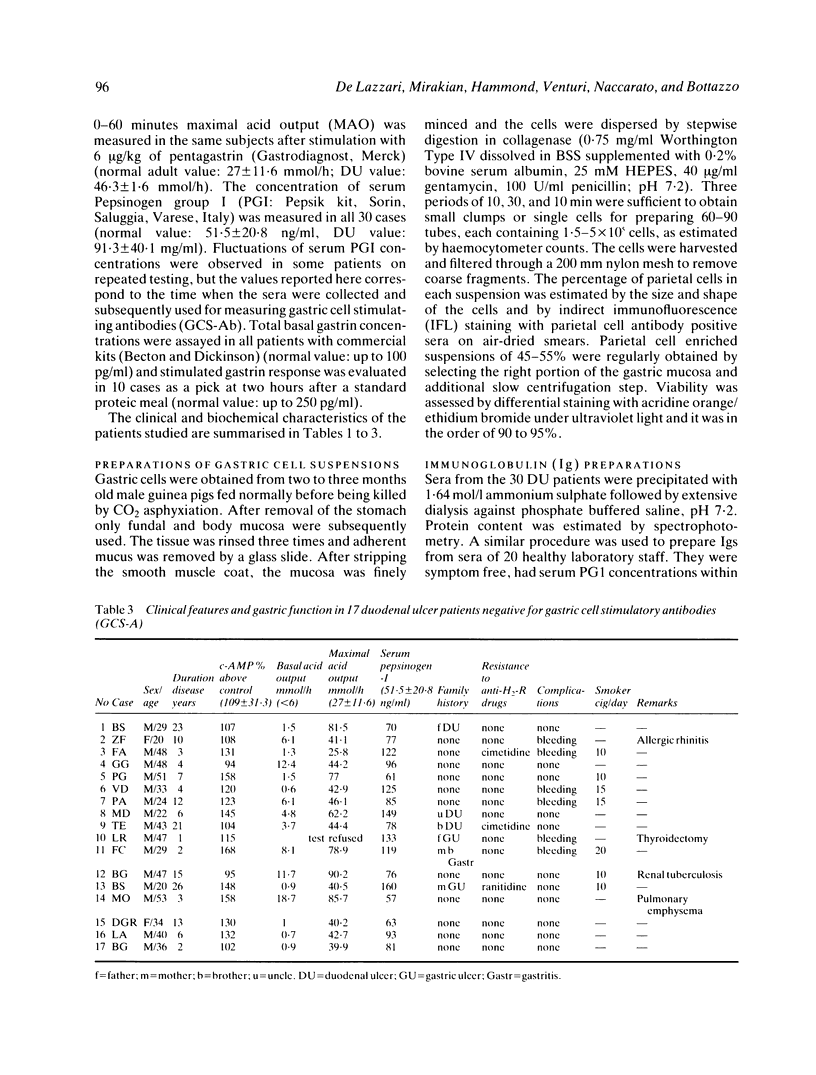
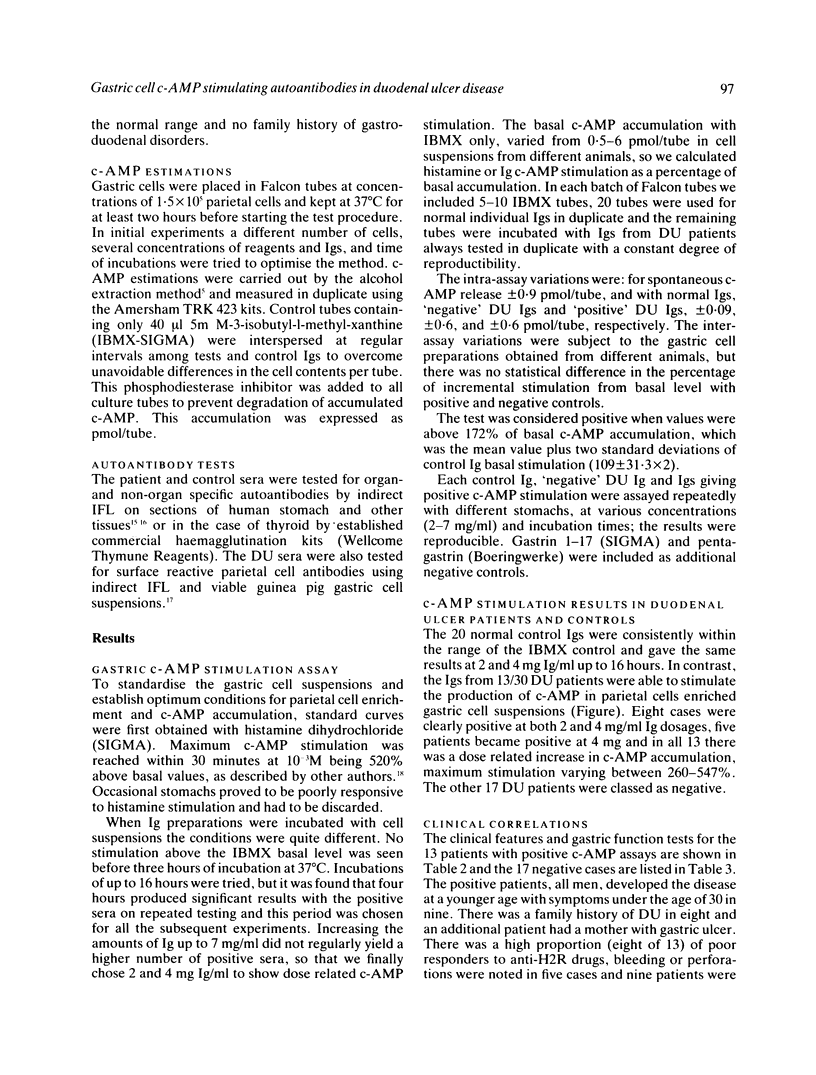

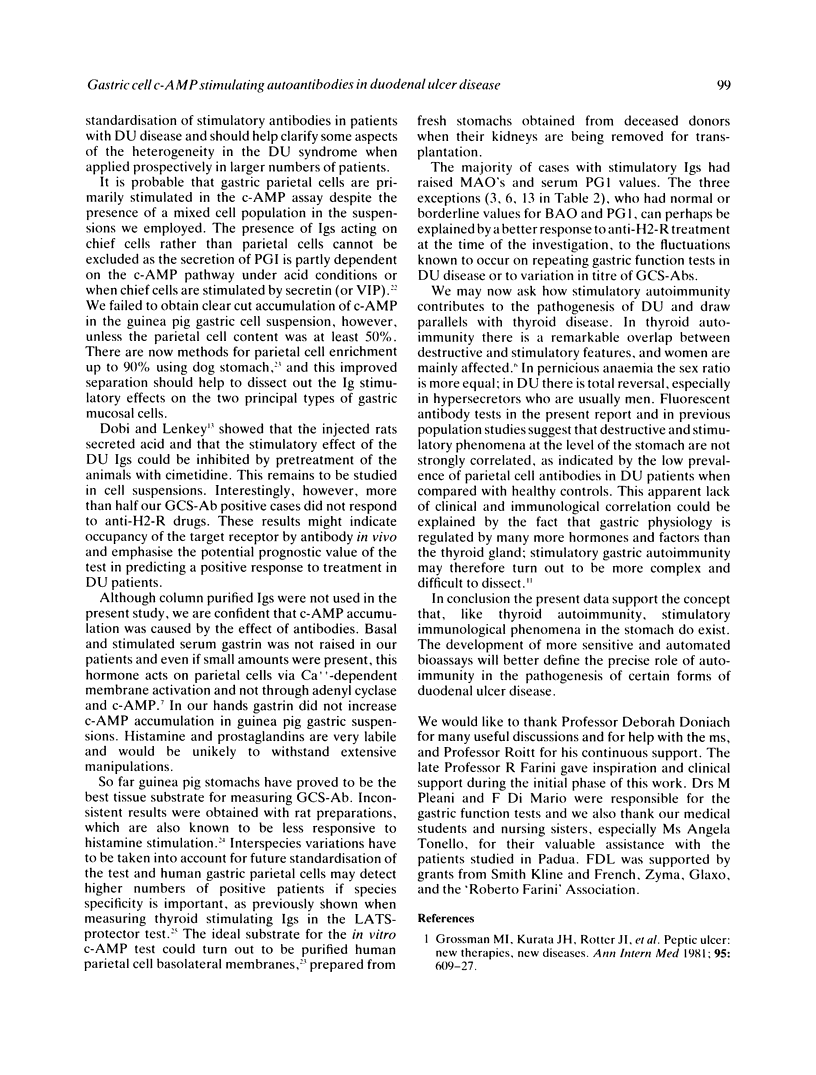
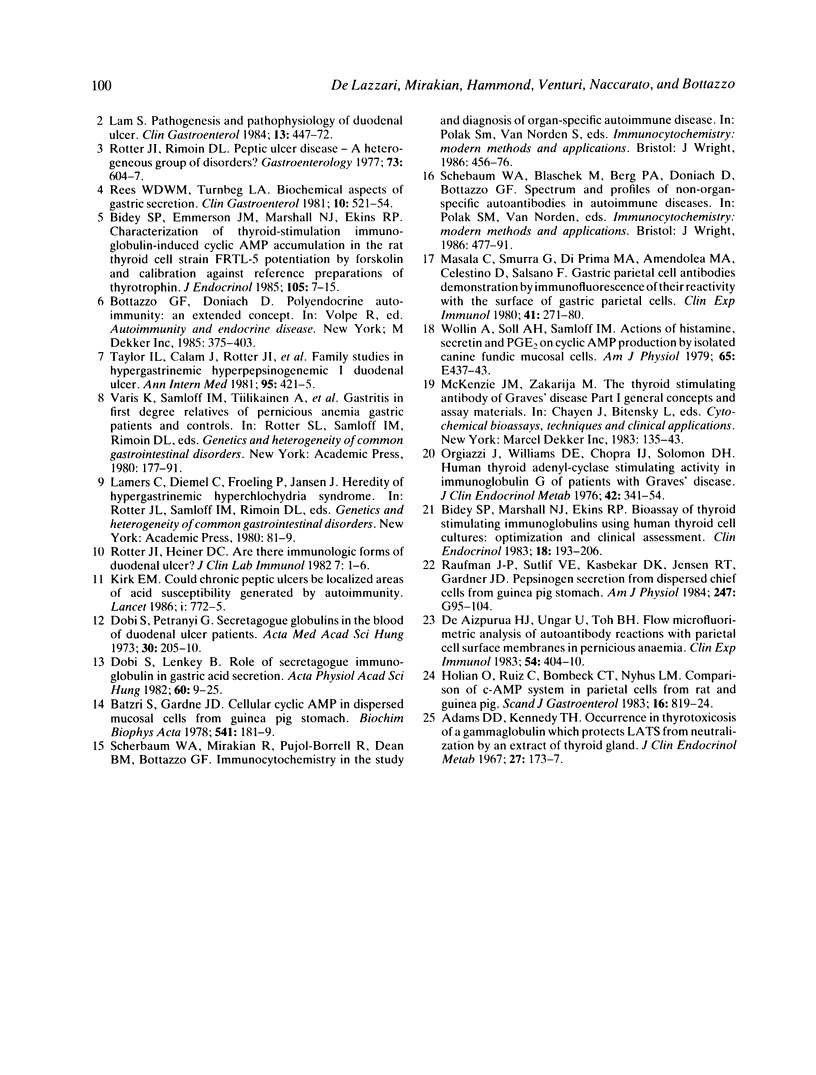
Selected References
These references are in PubMed. This may not be the complete list of references from this article.
- Adams D. D., Kennedy T. H. Occurrence in thyrotoxicosis of a gamma globulin which protects LATS from neutralization by an extract of thyroid gland. J Clin Endocrinol Metab. 1967 Feb;27(2):173–177. doi: 10.1210/jcem-27-2-173. [DOI] [PubMed] [Google Scholar]
- Batzri S., Gardner J. D. Cellular cyclic AMP in dispersed mucosal cells from guinea pig stomach. Biochim Biophys Acta. 1978 Jun 15;541(2):181–189. doi: 10.1016/0304-4165(78)90391-4. [DOI] [PubMed] [Google Scholar]
- Bidey S. P., Emmerson J. M., Marshall N. J., Ekins R. P. Characterization of thyroid-stimulating immunoglobulin-induced cyclic AMP accumulation in the rat thyroid cell strain FRTL-5: potentiation by forskolin and calibration against reference preparations of thyrotrophin. J Endocrinol. 1985 Apr;105(1):7–15. doi: 10.1677/joe.0.1050007. [DOI] [PubMed] [Google Scholar]
- Bidey S. P., Marshall N. J., Ekins R. P. Bioassay of thyroid-stimulating immunoglobulins using human thyroid cell cultures: optimization and clinical assessment. Clin Endocrinol (Oxf) 1983 Aug;19(2):193–206. doi: 10.1111/j.1365-2265.1983.tb02981.x. [DOI] [PubMed] [Google Scholar]
- Dobi S., Lenkey B. Role of a secretagogue immunoglobulin in gastric acid secretion. Acta Physiol Acad Sci Hung. 1982;60(1-2):9–25. [PubMed] [Google Scholar]
- Dobi S., Petrányi G. Secretagogue globulins in the blood of duodenal ulcer patients. Acta Med Acad Sci Hung. 1973;30(3):205–210. [PubMed] [Google Scholar]
- Grossman M. I., Kurata J. H., Rotter J. I., Meyer J. H., Robert A., Richardson C. T., Debas H. T., Jensen D. M. Peptic ulcer: new therapies, new diseases. Ann Intern Med. 1981 Nov;95(5):609–627. doi: 10.7326/0003-4819-95-5-609. [DOI] [PubMed] [Google Scholar]
- Holian O., Ruiz C., Bombeck C. T., Nyhus L. M. Comparison of cAMP system in parietal cells from rat and guinea pig. Scand J Gastroenterol. 1983 Sep;18(6):819–824. doi: 10.3109/00365528309182100. [DOI] [PubMed] [Google Scholar]
- Kirk R. M. Could chronic peptic ulcers be localised areas of acid susceptibility generated by autoimmunity? Lancet. 1986 Apr 5;1(8484):772–775. doi: 10.1016/s0140-6736(86)91785-x. [DOI] [PubMed] [Google Scholar]
- Lam S. K. Pathogenesis and pathophysiology of duodenal ulcer. Clin Gastroenterol. 1984 May;13(2):447–472. [PubMed] [Google Scholar]
- Masala C., Smurra G., Di Prima M. A., Amendolea M. A., Celestino D., Salsano F. Gastric parietal cell antibodies: demonstration by immunofluorescence of their reactivity with surface of the gastric parietal cells. Clin Exp Immunol. 1980 Aug;41(2):271–280. [PMC free article] [PubMed] [Google Scholar]
- Orgiazzi J., Williams D. E., Chopra I. J., Solomon D. H. Human thyroid adenyl cyclase-stimulating activity in immunoglobulin G of patients with Graves' disease. J Clin Endocrinol Metab. 1976 Feb;42(2):341–354. doi: 10.1210/jcem-42-2-341. [DOI] [PubMed] [Google Scholar]
- Raufman J. P., Sutliff V. E., Kasbekar D. K., Jensen R. T., Gardner J. D. Pepsinogen secretion from dispersed chief cells from guinea pig stomach. Am J Physiol. 1984 Jul;247(1 Pt 1):G95–104. doi: 10.1152/ajpgi.1984.247.1.G95. [DOI] [PubMed] [Google Scholar]
- Rees W. D., Turnberg L. A. Biochemical aspects of gastric secretion. Clin Gastroenterol. 1981 Sep;10(3):521–554. [PubMed] [Google Scholar]
- Rotter J. I., Rimoin D. L. Peptic ulcer disease--a heterogeneous group of disorders? Gastroenterology. 1977 Sep;73(3):604–607. [PubMed] [Google Scholar]
- Taylor I. L., Calam J., Rotter J. I., Vaillant C., Samloff I. M., Cook A., Simkin E., Dockray G. J. Family studies of hypergastrinemic, hyperpepsinogenemic I duodenal ulcer. Ann Intern Med. 1981 Oct;95(4):421–425. doi: 10.7326/0003-4819-95-4-421. [DOI] [PubMed] [Google Scholar]
- Wollin A., Soll A. H., Samloff I. M. Actions of histamine, secretin, and PGE2 on cyclic AMP production by isolated canine fundic mucosal cells. Am J Physiol. 1979 Nov;237(5):E437–E443. doi: 10.1152/ajpendo.1979.237.5.E437. [DOI] [PubMed] [Google Scholar]


